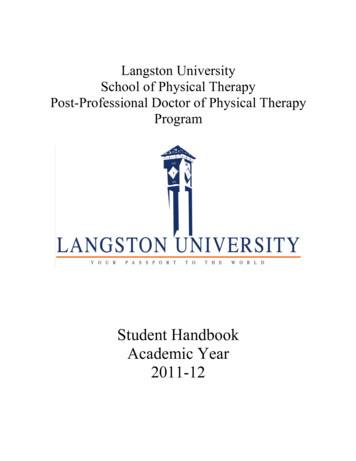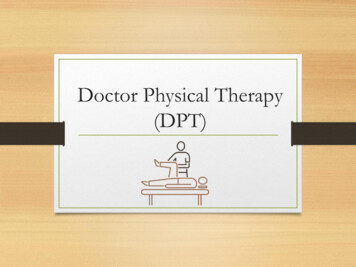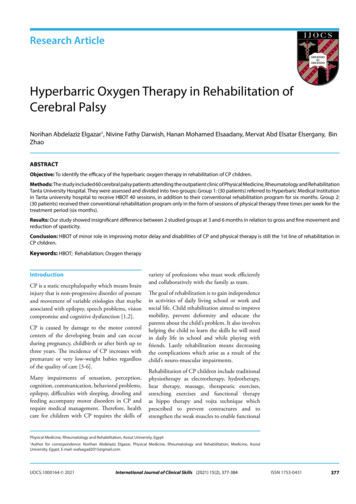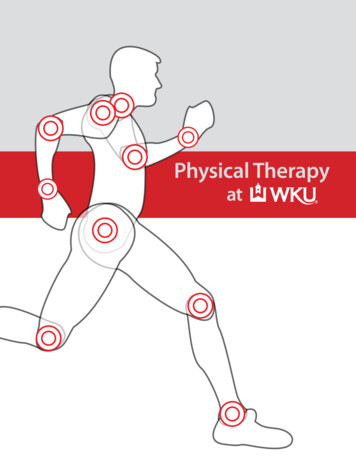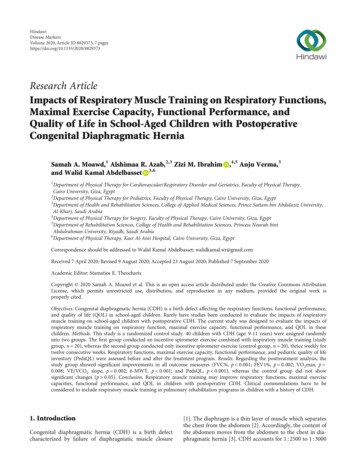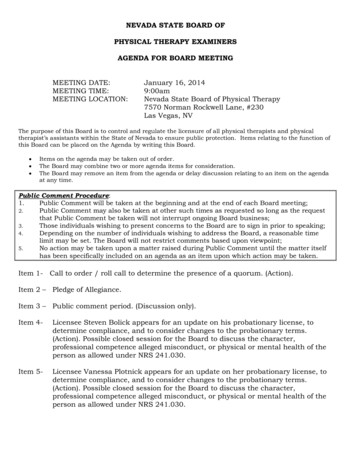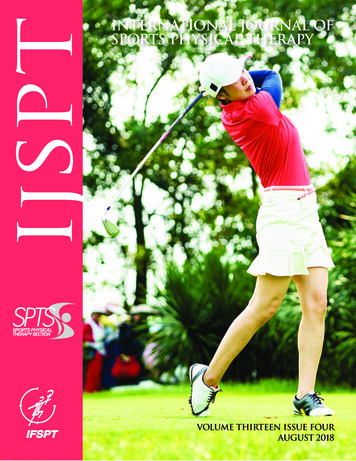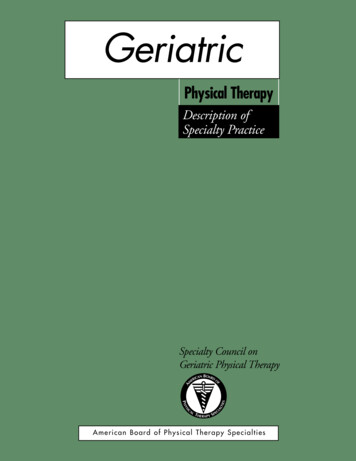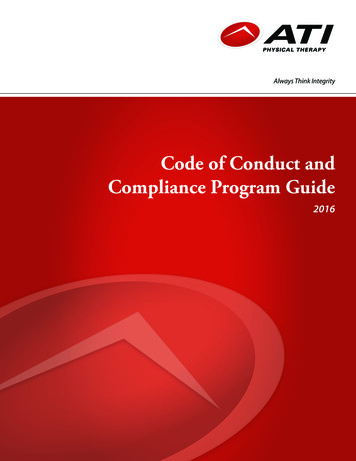
Transcription
CURRICULUMOFDOCTOR OFPHYSICAL THERAPY (DPT)5-YEARS DEGREE PROGRAMMEHIGHER EDUCATION COMMISSIONISLAMABAD – PAKISTAN1
CURRICULUM DIVISION, HECDr. Syed Sohail H. NaqviExecutive DirectorProf. Dr. Altaf Ali G. ShaikhMember (Acad)Mr. Muhammad Javed KhanAdviser (Academics)Mr. Malik Arshad MahmoodDirector (Curri)Dr. M. Tahir Ali ShahDeputy Director (Curri)Mr. Abdul Fatah BhattiAssistant Director (Curri)Composed by: Mr. Zulfiqar Ali, HEC, Islamabad2
CONTENTS1.Introduction . 62.Scheme of Studies for Doctor of PhysicalTherapy (DPT) 5-years degreeprogramme . .123.Details of Courses for Doctor of PhysicalTherapy (DPT) 5-years degree programme . 154.Recommendations 1915.Annexure 1923
PREFACEThe curriculum of subject is described as a throbbing pulse of a nation. Byviewing curriculum one can judge the stage of development and its pace ofsocio-economic development of a nation. With the advent of new technology,the world has turned into a global village. In view of tremendous researchtaking place world over new ideas and information pours in like of a stream offresh water, making it imperative to update the curricula after regular intervals,for introducing latest development and innovation in the relevant field ofknowledge.In exercise of the powers conferred under Section 3 Sub-Section 2 (ii) of Actof Parliament No. X of 1976 titled “Supervision of Curricula and Textbooksand Maintenance of Standard of Education” the erstwhile University GrantsCommission was designated as competent authority to develop review andrevise curricula beyond Class-XII. With the repeal of UGC Act, the samefunction was assigned to the Higher Education Commission under itsOrdinance of 2002 Section 10 Sub-Section 1 (v).In compliance with the above provisions, the HEC undertakes revamping andrefurbishing of curricula after regular intervals in a democratic mannerinvolving universities/DAIs, research and development institutions and localChamber of Commerce and Industry. The intellectual inputs by expatriatePakistanis working in universities and R&D institutions of technically advancedcountries are also invited to contribute and their views are incorporated whereconsidered appropriate by the National Curriculum Revision Committee(NCRC).To bring international compatibility to qualifications held from Pakistaniuniversities/DAIs for promotion of student’s mobility and job seekers aroundthe globe, a Committee comprising of Conveners of the National CurriculumRevision Committee of HEC met in 2009 and developed a unified template forstandardized 5-years/10-semesters DPT degree programmes. This unifiedtemplate was aimed to inculcate broader base of knowledge in the subjectslike English, Sociology, Philosophy, Economics etc in addition to majordiscipline of study. The DPT degree course requires to be completed in 5years/10-semesters, and shall require qualifying of 175 credit hours of which77% of the curriculum will constitute discipline specific and remaining 23% willcomprise compulsory and general courses.In line with above, NCRC comprising senior university faculty and experts fromvarious stakeholders and the respective accreditation councils has finalizedthe curriculum for DPT 5-years in Physical Therapy. The same is beingrecommended for adoption by the universities/DAIs channelizing throughrelevant statutory bodies of the universities.MUHAMMAD JAVED KHANAdviser (Academics)June, 20114
CURRICULUM DEVELOPMENTSTAGE-ISTAGE-IISTAGE-IIISTAGE-IVCURRI. UNDERCONSIDERATIONCURRI. IN DRAFTSTAGEFINAL STAGEFOLLOW UPCOLLECTION OFEXPNOMINATIONUNI, R&D,INDUSTRY &COUNCILSAPPRAISAL OF 1STDRAFT BY EXPPREP. OF FINALCURRI.QUESTIONNAIRECONS. OF NCRC.FINALIZATION OFDRAFT BY NCRCCOMMENTSPRINTING OFCURRI.PREP. OF DRAFTBY NCRCREVIEWIMPLE. OFCURRI.Abbreviations Used:NCRC. National Curriculum Revision CommitteeVCC.Vice-Chancellor’s IENTATIONCOURSES BYLI, HECBACK TOSTAGE-IPREP. PreparationREC.RecommendationsLILearning InnovationR&DResearch & Development OrganizationHECHigher Education Commission5
INTRODUCTIONFinal meeting of National Curriculum Revision Committee to review andrevise the Curriculum for Physical Therapy at degree level was held at HECRegional Centre, Karachi from May 04-06, 2011. List of participants ofmeeting is as under:Sr.Name1. Mr. Riaz Baig ChughtaiPrincipal,College of Physiotherapy,Jinnah Post Graduate Medical Centre (JPMC),Karachi.Convener2. Mr. Akhtar RasulAssistant Professor/HOD,Department of Physiotherapy,University of Faisalabad,Faisalabad.Member3. Mr. Khalid AzizAssistant Professor,Ziauddin College of Physical Therapy,Ziauddin Medical University,Karachi.Member4. Dr. Fareeha Shah, DPT (USA)(Fatima Memorial Hospital),Institute of Allied Health Sciences, College Building,Room No. 10-B, Shadman,Lahore.Member5. Dr. Awais Bin InamLecturer / Incharge,Department of Physical Therapy,Sarghoda Medical College,University of Sargodha,Sargodha.Member6. Mr. Khalid Saeed KhanPrincipal, School of Physiotherapy,Mayo Hospital,Lahore.Member7. Mr. Syed Hasan AbbasPrincipal,Liaquat National School of Physiotherapy,Liaquat National Hospital (LNH)Karachi.Member6
8. Mrs. Samira MalikConsultant Physiotherapist,Department of Rheumatology and Physical Medicine,Pakistan Institute of Medical Sciences,Islamabad.Member9. Dr. Muhammad Naveed Babur,Principal / Assistant professor,ISRA University,ISRA School of Rehabilitation Sciences (ISRS),Islamabad Campus.Member10. Mr. Muhammad Bin Afsar Jan,Institute of Physical Medical & Rehabilitation,Khyber Medical University,Block-IV, PDA Building, Phase-V, Hayatabad,Peshawar.Member11. Syed Ali ShahSenior Lecturer,College of Physiotherapy, JPMC,Coordinator Academics Pakistan,Physiotherapy Society.Member12. Muhammad AsifAssistant Professor,Deputy General Secretary,Pakistan Physiotherapy Society.Member13. Dr. Asghar Khan,Director, PT, DPT (USA),Riphah College of Rehabilitation,Riphah International University,Sector I-14, Islamabad.SecretaryThe meeting started with recitation from the Holy Quran by Dr. NaveedBabur. Mr. Muhammad Javed Khan, Adviser (Academics) welcomed theparticipants and informed the members of the committee about procedure forreview and revision. He also informed the members of the committeeregarding legal obligations as assigned to the Commission under its law andin accordance with the provisions of Act No. XII of 1976 titled FederalSupervision of Curricula & Text Books. He emphasized the need forpreparation of curriculum in academics of Physical Therapy knowledge, newtechniques and methodologies evolving world over dictating the professionalsto keep pace with time and adopt these changes for the need of futureprofessionals. He emphasized for the semester based undergraduatecurriculum in a standardized format/scheme of studies set by HEC.7
Mr. Riaz Baig Chughtai, Principal College of Physiotherapy Jinnah PostGraduate Medical Centre (JPMC), Karachi, Convener and Dr. Asghar Khan,Director, Riphah College of Rehabilitation Sciences (RCRS), RiphahInternational University, Islamabad, Secretary NCRC briefly described thehistory of physiotherapy being taught in the world class universities of theworld, scheme of studies, duration and curriculum. The Convener and theSecretary thanked the members for reposing confidence and assure them oftheir fullest cooperation and intellectual inputs during the course ofproceedings. The house unanimously agreed to adopt 5 years programDoctor of Physical Therapy (DPT).Malik Arshad Mahmood, Director Curriculum HEC Islamabad thanked to theConvener, Secretary and the member of the Committee for sparing their timeand lot of professional contribution towards preparation of the final draftcurriculum for Physical Therapy.The committee unanimously approved the final draft of Curriculum ofPhysical Therapy. The committee highly appreciated the efforts made by theofficials of HEC Regional Center, Karachi and Mr. Malik Arshad Mahmood,Director, Curriculum for making nice arrangements to facilitate the committeeand comfortable stay of the members at Karachi.All members of NCRC really admire the efforts of Director Curriculum beingmade from day one to End of all activities of members.The Meeting ended with the vote of thanks to the HEC, Convener, Secretaryand members of National Curriculum Revision Committee. Committee hasreally admired the contribution of HEC for the ignored field of PhysicalTherapy.8
Proceedings of NCRC (Physical Therapy)Day-0104-May- 2011.Technical session -1, the NCRC members discussed the scheme of study atstructural level in detail. All the members submitted their suggestion, after along discussion; committee reviewed the Scheme of study for the Doctor ofPhysical Therapy degree programme in Pakistan at graduate level and in thetechnical session –II, NCRC members reviewed the contents of Doctor ofPhysical Therapy (DPT) courses along with the recent books available for thefirst five semesters of DPT.The session ended at 06:00 pm.Day -0205-May-2011.Technical Session-III: Meeting started with the recitation from the HolyQuran. NCRC members reviewed the final draft of course contents alongwith recommended books in the technical session for 6th to 10th semester ofDPT.Technical Session-IV: The members drafted the supervised clinical practicedocument from 5th to 10th semester and finalized the course contents alongwith the recommended books. The session ended at 7:00 p.m.Day -0306-May-2011Technical Session-V: Proceeding started with recitation of the Holy Quran. Inthe technical session the committee debated on the contents of all thesubjects included in the DPT curriculum and also discussed the module ofclinical practice at graduate level from 5th to 10th semester.Technical Session-VI: The final draft of curriculum was reviewed andsubmitted to the Director curriculum at the end of the session.9
RATIONALEPhysical therapy is an essential segment of modern health caresystem. It is a “science of healing and art of caring”. It pertains to the clinicalexamination, evaluation, assessment, diagnosis and treatment ofmusculoskeletal, Neurological, Cardio-Vascular and Respiratory systems’functional disorders including symptoms of pain, edema, physiological,structural and psychosomatic ailments. It deals with methods of treatmentbased on movement, manual therapy, physical agents, and therapeuticsmodalities to relieve the pain and other complications.Hence, Physical therapy covers basic parameters of healing sciencesi.e. preventive, promotive, diagnostic, rehabilitative, and curative.GOALS OF THE PROGRAMME:THE PURPOSE OF THE DOCTOR OF PHYSICAL THERAPYPROGRAMME (DPT) IS TO PREPARE PHYSICAL THERAPISTS WHOWILL:1. Be primary providers of physical therapy care.2. Serve as responsible members in the professional community and arewilling and able to assume leadership roles in the communities theyserve.3. Identify researchable problems, advocate and participate in research,and incorporate research findings into clinical practice.4. Understand and place in context the social, economic and culturalissues of practice and effectively advocate for changes in policy.5. Correlate theory with practice and think creatively about, react to,adapt or shape new practice environments.6. Participate in and provide education for communities, patients, peers,students and others.OBJECTIVES OF THE PROGRAMME:GRADUATES OF THE DOCTOR OF PHYSICAL THERAPY PROGRAMMEWILL:1. Demonstrate in-depth knowledge of the basic and clinical sciencesrelevant to physical therapy, both in their fundamental context and intheir application to the discipline of physical therapy.10
2. Understand, correlate and apply theoretical foundations of knowledgeto the practice of physical therapy; evaluate and clarify new or evolvingtheory relevant to physical therapy.3. Demonstrate the behaviors of the scholarly clinician by developing andutilizing the process of critical thinking and inquiry, particularly focusedon the improvement of the practice of physical therapy and the deliveryof health care.4. Engage in reflective practice through sound clinical decision making,critical self-assessment and commitment to lifelong learning.5. Demonstrate mastery of entry level professional clinical skills.Provision of these services is based on the best available evidenceand includes physical therapy examination, evaluation, diagnosis,prognosis, intervention, prevention activities, wellness initiatives andappropriate health care utilization.6. Prepared to influence the development of human health careregulations and policies that are consistent with the needs of thepatient and of the society.7. Demonstrate leadership, management, and communication skills toeffectively participate in physical therapy practice and the health careteam.8. Incorporate and demonstrate positive attitudes and behaviours to allpersons.9. Demonstrate the professional and social skills to adapt to changinghealth care environments to effectively provide physical therapy care.11
SCHEME OF STUDIES FOR 5-YEARSDOCTOR OF PHYSICAL THERAPY (DPT) PROGRAMMESEMESTER/YEARFIRSTSECONDNAME OF SUBJECTFIRST PROFESSIONAL YEARANATOMY –IPHYSIOLOGY-IKINESIOLOGY-IENGLISH-I (FUNCTIONAL ENGLISH)PAKISTAN -0)ANATOMY –IIPHYSIOLOGY-IIKINESIOLOGY-IIENGLISH-II (COMMUNICATION SKILLS)ISLAMIC STUDIES / ETHICSBIOSTATISTICS-II / UNIVERSITYOPTIONAL18THIRDFOURTHFIFTHSECOND PROFESSIONAL YEARENGLISH-III((TechnicalWritingPresentation Skills)INTRODUCTION TO COMPUTERANATOMY –IIIPHYSIOLOGY-IIIBIOMECHANICS & ERGONOMICS-IBIOCHEMISTRY & GENETICS IANATOMY-IV (Neuro Anatomy)BIOMECHANICS & ERGONOMICS-IIBEHAVIORAL SCIENCES(Psychiatry & Psychology)BIOCHEMISTRY& GENETICS IIEXERCISE PHYSIOLOGYMEDICAL PHYSICSTHIRD PROFESSIONAL YEARPATHOLOGY & MICROBIOLOGY IPHARMACOLOGY IPHYSICAL AGENTS &ELECTROTHERAPY ITHERAPEUTIC EXERCISES -0)3(3-0)3(2-1)3(2-1)2(2-0)12
HEALTH & WELLNESSSUPERVISED CLINICAL PRACTICE ISIXTHSEVENTHEIGHTNINTHTENTHPATHOLOGY & MICROBIOLOGY IIPHARMACOLOGY IIPHYSICAL AGENTS &ELECTROTHERAPY -IIMANUAL THERAPYTEACHING METHODOLOGY &COMMUNITY MEDICINESUPERVISED CLINICAL PRACTICE IIFOURTH PROFESSIONAL YEARMEDICINE ISURGERY IRADIOLOGY & DIAGNOSTIC IMAGINGMUSCULOSKELETALPHYSICALTHERAPYHUMAN GROWTH, DEVELOPMENT &COMMUNITY BASED REHABILITATIONSUPERVISED CLINICAL PRACTICE IIIMEDICINE IISURGERY IINEUROLOGICAL PHYSICAL THERAPYEVIDENCE BASED PRACTICEPROSTHETICS & ORTHOTICSSUPERVISED CLINICAL PRACTICE IVFIFTH PROFESSIONAL YEARCARDIOPULMONARY PHYSICALTHERAPYEMERGENCY PROCEDURES & PRIMARYCARE IN PHYSICAL THERAPYCLINICAL DECISION MAKING &DIFFERENTIAL DIAGNOSISSCIENTIFIC INQUIRY & RESEARCHMETHODOLOGYPROFESSIONAL PRACTICE(LAWS , ETHICS &ADMINISTRATION)INTEGUMENTRY PHYSICAL THERAPYSUPERVISED CLINICAL PRACTICE VOBSTETRICS & GYNAECOLOGICALPHYSICAL -0)3(2-1)2(2-0)2(2-0)3(0-3)182(2-0)13
PAEDIATRIC PHYSICAL THERAPYGERONTOLOGY & GERIATRIC PHYSICALTHERAPYSPORTS PHYSICAL THERAPYSUPERVISED CLINICAL PRACTICE VIRESEARCH PROJECTTOTAL CREDITS2(2-0)2(2-0)2(2-0)4(0-4)618175Note * This scheme of curriculum is also applicable to annual system; inwhich two consecutive semesters will be considered as oneprofessional year. Credit hours distribution is as following: Theory: one credit hour shall be equal to one hour of teachingper week throughout the semester. Practical / lab: one credit hour shall be equal to two hours of labwork per week throughout the semester. Clinical: one credit hour shall be equal to three hours of clinicalwork per week throughout the semester. Research: One credit hour shall be equal to three hours ofresearch work per week throughout the semester.HOUSE JOBOne year of house job will be incorporated at the end of five year degreeprogramme.14
FIRST SEMESTER1.2.3.4.5.6.ANATOMY -IPHYSIOLOGY-IKINESIOLOGY-IENGLISH-I (FUNCTIONAL ENGLISH)PAKISTAN STUDIESBIOSTATISTICS-IDETAIL OF COURSESANATOMY- ICREDIT HOURS 4 (3-1)COURSE DESCRIPTION:The focus of this course is an in-depth study and analysis of the regional andsystemic organization of the body. Emphasis is placed upon structure andfunction of human movement. A comprehensive study of human anatomywith emphasis on the nervous, musculoskeletal, and circulatory systems isincorporated. Introduction to general anatomy lays the foundation of thecourse. Dissection and identification of structures in the cadaversupplemented with the study of charts, models, prosecuted materials andradiographs are utilized to identify anatomical landmarks and configurationsof the upper limb and thoracic region.CELL BIOLOGYGENERAL ANATOMY: Terms related to position and movements The skin and subcutaneous tissues Layers of skin Integuments of skin Glands associated with hair follicle Microscopic picture of skinBONES AND CARTILAGES: Osteology Functions of Bones Classification of bones Parts of developing long bones Blood supply of bones Lymphatic vessels & nerve supply Rule of direction of nutrient foramen Gross structure of long bone Surface marking15
Cartilage Development of bone and cartilage Microscopic picture of cartilage and boneTHE MUSCLE: Introduction Histological Classification Functions of muscles in general Type of skeletal muscles Parts of skeletal muscle and their action Nomenclature. Microscopic picture of muscleSTRUCTURES RELATED TO MUSCLES & BONES: Tendons Aponeurosis Fasciae Synovial bursae Tendon Synovial sheaths Raphaes Ligaments Condyle Epicongyle Ridge Tuberosity Tubercle Foramen Canal Groove Process SpurTHE JOINTS: Introduction Functional classifications Structural classification Structures comprising a Synovial joint Movements of joints Blood supply of Synovial joints, their nerve supply and lymphaticdrainage Factors responsible for joint stability. Development of jointsCARDIOVASCULAR SYSTEM: Definition16
Division of circulatory system into pulmonary & systemicClassification of blood vessels and their microscopic pictureHeart and its histologyFunction of the HeartAnastomosisNERVOUS SYSTEM: Definition Outline of cellular architecture Classification of nervous system Parts of the central nervous system Microscopic picture of cerebrum, cerebellum, spinal cord Functional components of a nerve Typical spinal nerve Microscopic picture of nerve Introduction of autonomic nervous system Anatomy of neuromuscular junctionUPPER LIMBOSTEOLOGY: Detailed description of all bones of upper limb and shoulder girdlealong their musculature and ligamentous attachments.MYOLOGY: Muscles connecting upper limb to the axial skeletal Muscles around shoulder joint Walls and contents of axilla Muscles in brachial region Muscles of forearm Muscles of hand. Retinacula, Palmar apouenrosis Flexor tendon dorsal digital expansionNEUROLOGY: Course, distribution and functions of all nerves of upper limb Brachial plexusANGIOLOGY (CIRCULATION): Course and distribution of all arteries and veins of upper limb. Lymphatic drainage of the upper limb Axillary lymph node Cubital fossa17
ARTHROLOGY: Acromioclavicular and sternoclavicular joints Shoulder joint Elbow joint Wrist joint Radioulnar joints Inter carpal joints Joints MCP and IP Surface Anatomy of upper limb Surface marking of upper limbDEMONSTARIONS: Demonstration on Shoulder joint, attached muscles and articulatingsurfaces. Demonstration on Elbow joint Demonstration on Wrist joint Demonstration on Radioulnar joint Demonstration on MCP and IP joints Demonstration on acromioclavicular joint Demonstration on sternoclavicular joint Demonstration on Brachial plexus Demonstration of blood supply of brain Demonstration on Structure of bonesTHORAXSTRUCTURES OF THE THORACIC WALL: Dorsal spine (Vertebrae) Sternum Costal Cartilages & Ribs Intercostal Muscles Intercostal Nerves Diaphragm Blood supply of thoracic wall Lymphatic drainage of thoracic wall Joints of thoraxTHORACIC CAVITY: Mediastinum Pleura Trachea Lungs Bronchopulmonary segments Pericardium Heart – Its blood supply, venous drainage & nerve supply18
Large veins of thorax, superior and in-ferior vena cava., pulmonaryveins brachiocephalic veins Large Arteries – Aorta & its branchesPRACTICAL:During study of Gross Anatomy, emphasis should be given on appliedaspect, radiological anatomy, surface anatomy and cross-sectional anatomyof the region covered in the respective semester /yearRECOMMENDED TEXT BOOKS:1.2.3.4.5.6.7.8.9.Gray’s Anatomy by Prof. Susan Standing 39th Ed., Elsevier.Clinical Anatomy for Medical Students by Richard S. Snell.Clinically Oriented Anatomy by Keith Moore.Clinical Anatomy by R. J. Last, Latest Ed.Cunningham’s Manual of Practical Anatomy by G. J. Romanes, 15th Ed.,Vol-I, II and III.The Developing Human. Clinically Oriented Embryology by Keith L.Moore, 6th Ed.Wheater’s Functional Histology by Young and Heath, Latest Ed.Medical Histology by Prof. Laiq Hussain.Neuroanatomy by Richard S. Snell.PHYSIOLOGY- ICR. HR. 3 (2-1)COURSE DESCRIPTION:The course is designed to study the function of the human body at themolecular, cellular, tissue and systems levels. The major underlying themesare: the mechanisms for promoting homeostasis; cellular processes ofmetabolism, membrane function and cellular signaling; the mechanisms thatmatch supply of nutrients to tissue demands at different activity levels; themechanisms that match the rate of excretion of waste products to their rate ofproduction; the mechanisms that defend the body against injury and promotehealing.These topics are addressed by a consideration of nervous and endocrineregulation of the cardiovascular, hematopoietic, pulmonary, renal,gastrointestinal, and musculoskeletal systems including the control of cellularmetabolism. The integrative nature of physiological responses in normalfunction and disease is stressed throughout the course.This course will sever as pre requisite for the further courses i.e. exercisephysiology, pathology, etc.19
COURSE OUTLINE:BASIC AND CELL PHYSIOLOGY: Functional organization of human body Homeostasis Control systems in the body Cell membrane and its functions Cell organelles and their functions Genes: control and functionNERVE AND MUSCLE: Structure and function of neuronPhysiological properties of nerve fibersPhysiology of action potentialConduction of nerve impulseNerve degeneration and regeneration.SynapsesPhysiological structure of muscle,Skeletal muscle contraction,Skeletal, smooth and cardiac muscle contraction.Neuromuscular junction and transmission,Excitation contraction coupling,Structure and function of motor unitClinical Module:1. Perform nerve conduction studies and explain their clinical importance2. Myopathies and neuropathies3. Peripheral nerve injuriesCARDIOVASCULAR SYSTEM: Heart and circulation Function of cardiac muscle Cardiac pacemaker and cardiac muscle contraction Cardiac cycle ECG: recording and interpretation Common arrhythmias and its mechanism of development Types of blood vessels and their function Haemodynamics of blood flow (local control systemic circulation itsregulation and control). Peripheral resistance its regulation and effecton circulation Arterial pulse Blood pressure and its regulation Cardiac output and its control Heart sounds and murmurs Importance in circulation and control ofvenous return.20
Coronary circulationSplanchnic, pulmonary and cerebral circulationTriple response and cutaneous circulationFoetal circulation and circulatory changes at birthClinical Module:1. Clinical significance of cardiac cycle, correlation of ECG and heartsounds to cardiac cycle2. Clinical significance of cardiac cycle, interpretation of ischemia andarrhythmias3. Effects of hypertension4. Clinical significance of heart sounds5. Effects of ischemia6. ShockPRACTICALS:Cardiovascular System Cardiopulmonary resuscitation (to be coordinated with the departmentof medicine) Examination of arterial pulse ECG recording and interpretation Arterial blood pressure Effects of exercise and posture on blood pressure Apex beat and normal heart soundsRECOMMENDED BOOKS:1.2.3.4.5.Textbook of Physiology by Guyton and Hall, Latest Ed.Review of Medical Physiology by William F. Ganong, Latest Ed.Physiology by Berne and Levy, Latest Ed.Human Physiology: The Basis of Medicine by Gillian Pocock,Christopher D. RichardsPhysiological Basis of Medical Practice by John B. West and Taylor,12th Ed.KINESIOLOGY- ICREDIT HOURS 3 (2-1)COURSE DESCRIPTION:This course covers the definition of kinesiology as well as its importance inphysical therapy. It identifies the scope of kinesiology and studies itsapplication. It covers the types of human motions as well as plane andrelative axis of motion. It also explains the inter-relationship among kinematicvariables and utilizes this knowledge to describe and analyze motion. Thiscourse additionally covers the classification of the joints and muscles along21
their distinguishing characteristics; group action of muscles arthrokinematicsand osteokinematics of human movement.COURSE OUTLINE:INTRODUCTION TO KINESIOLOGY Definition of kinesiology Definition of rehabilitationMECHANICS:Mechanical Principles and Mechanics of Position Force - force system – Description of units. Gravity: Center of gravity and line of gravity Level of gravity Equilibrium Fixation and StabilizationMechanics of movement Axes /Plane Speed Velocity Acceleration Momentum Inertia Friction Lever - types - application Pulley - types - application Anatomical application of lever system and other pulley systemapplication Angle of pullINTRODUCTION TO MOVEMENT: The body levers Forces applied to the body levers Types of movement and posture Patterns of movement Timing in movement Rhythm of movement The nervous control of movementSTARTING POSITIONS: Definition Fundamental positions Standing Kneeling Sitting22
Lying Hanging The pelvic tiltPOSTURE: Inactive postures Active postures The postural mechanism The pattern of posture Principles of Re- Education Techniques of Re-Education Prevention of muscles wasting The initiation of muscular contraction Strengthening methods Abnormal posturesMUSCLE STRENGTH AND MUSCLE ACTION: Types of Muscles contraction Muscles tone Physiological application to postural tone Group action of muscles Overview of muscle structure Types of muscle work Range of muscle work Group action of muscles Two joint muscle work Active and passive insufficiency Group movement of joints Muscular weakness and paralysisPRACTICAL TRAINING/ LAB WORK: Fundamentals of muscle testingMethods of muscle recordingBasic muscle grading systemEvaluation of postureRegional upper limb muscle testing as the region is covered inAnatomy I Practical demonstrations of muscles work and its ranges Practical demonstrations of various fundamental positions and postureanalysis.RECOMMENDED TEXT BOOKS:1.2.3.Practical exercise therapy by Margaret HollisBrunnstrom’s Clinical KinesiologyClinical kinesiology and anatomy by Lynn S Lippert23
4.Joint structure and function: a comprehensive analysis by: Pamela. K.Levangie and Cynthia. C. Norkin.Muscle function testing by: Cunningham and Daniel.Human movement explain by kim jonas and karenbakerThe principles of exercise therapy by: M. Dena Gardiner, 4th Edition.5.6.7.ENGLISH- IFUNCTIONAL ENGLISHCREDIT HOURS 3 (3-0)Objectives:Enhance language skills and develop critical thinking.COURSE CONTENTS: Basics of GrammarParts of speech and use of articlesSentence structure, active and passive voicePractice in unified sentenceAnalysis of phrase, clause and sentence structureTransitive and intransitive verbsPunctuation and spelling.Comprehension Answers to questions on a given textDiscussion General topics and every-day conversation (topics for discussion to beat the discretion of the teacher keeping in view the level of students)Listening To be improved by showing documentaries/films carefully selected bysubject teachersTranslation skills Urdu to EnglishParagraph writing Topics to be chosen at the discretion of the teacherPresentation skills IntroductionNote: Extensive reading is required for vocabulary building.RECOMMENDED TEXT BOOKS:Functional EnglishGrammar1. Practical English Grammar by A. J. Thomson and A. V. Martinet.Exercises 1. Third edition. Oxford University Press. 1997. ISBN019431349224
2. Practical English Grammar by A. J. Thomson and A. V. Martinet.Exercises 2. Third edition. Oxford University Press. 1997. ISBN0194313506Writing1. Writing. Intermediate by Marie-Christine Boutin, Suzanne Brinand andFrancoise Grellet. Oxford Supplementary Skills. Fourth Impression1993. ISBN 0 19 435405 7 Pages 20-27 and 35-41.2. Reading/Comprehension3. Reading. Upper Intermediate. Brain Tomlinson and Rod Ellis. OxfordSupplementary Skills. Third Impression 1992. ISBN 0 19 453402 2.4. Speaking.PAKISTAN STUDIES (COMPULSORY)CREDIT HOURS 2 (2-0)Introduction/Objectives: Develop vision of historical perspective, government, politics,contemporary Pakistan, ideological background of Pakistan. Study the process of governance, national development, issues arisingin the modern age and posing challenges to Pakistan.COURSE OUTLINE: Historical Perspective Ideological rationale with special reference to Sir Syed AhmedKhan, Allama Muhammad Iqbal and Quaid-e-Azam MuhammadAli Jinnah. Factors leading to Muslim separatism People and Land Indus Civilization Muslim advent Location and geo-physical features. Government and Politics in PakistanPolitical and constitutional phases: 1947-58 1958-71 1971-77 1977-88 1988-99 1999
Physical Therapy degree programme in Pakistan at graduate level and in the technical session –II, NCRC members reviewed the contents of Doctor of Physical Therapy (DPT) courses along


